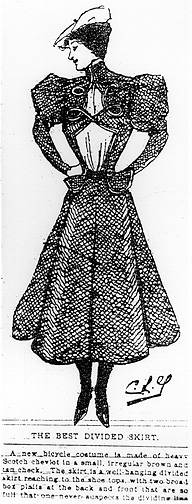The Bifurcated Skirt: Difference between revisions
m added page content type |
No edit summary |
||
| (5 intermediate revisions by 2 users not shown) | |||
| Line 1: | Line 1: | ||
'''<font face = Papyrus> <font color = maroon> <font size = 4>Historical Essay</font></font> </font>''' | '''<font face = Papyrus> <font color = maroon> <font size = 4>Historical Essay</font></font> </font>''' | ||
''by Mae Silver'' | ''by Mae Silver, excerpted from [[The Sixth Star| The Sixth Star]]'' | ||
[[Image:Bicycleskirt grayscale.jpg]] | [[Image:Bicycleskirt grayscale.jpg]] | ||
| Line 7: | Line 7: | ||
'''The Best Divided Skirt, from Fourth Star handout''' | '''The Best Divided Skirt, from Fourth Star handout''' | ||
''Photo: The Bancroft Library, | ''Photo: The Bancroft Library, Berkeley, CA'' | ||
In 1892 at the posh Palace Hotel in downtown San Francisco, Anna Janess Miller, editor and owner of her own magazine, ''Janess Miller Monthly'', hosted a fashion show of her bifurcated skirts. Through her periodical, she sold patterns and designs of the divided skirt, all the rage with the women's bicycle set. Curiously, in 1851, another Miller, Elizabeth Smith Miller, cousin to Elizabeth Cady Stanton, originated the first woman's pants creation, the bloomer costume. The women's magazine ''Lily'' advocated the bloomer as a response to women's concern for the safety of wearing long skirts and the unsanitary conditions of long trailing skirts in contact with mud and dirt of unpaved streets. The [[CYCLERS RIDE IN GAY ATTIRE | bicycle craze]] that hit San Francisco around 1895 provoked a need for a safe tangle-free costume for the new woman who wanted her own wheels, another sign of a liberated, emancipated woman who wanted to move in her own time, rhythm, and place. | In 1892 at the posh Palace Hotel in downtown San Francisco, Anna Janess Miller, editor and owner of her own magazine, ''Janess Miller Monthly'', hosted a fashion show of her bifurcated skirts. Through her periodical, she sold patterns and designs of the divided skirt, all the rage with the women's bicycle set. Curiously, in 1851, another Miller, Elizabeth Smith Miller, cousin to Elizabeth Cady Stanton, originated the first woman's pants creation, the bloomer costume. The women's magazine ''Lily'' advocated the bloomer as a response to women's concern for the safety of wearing long skirts and the unsanitary conditions of long trailing skirts in contact with mud and dirt of unpaved streets. The [[CYCLERS RIDE IN GAY ATTIRE | bicycle craze]] that hit San Francisco around 1895 provoked a need for a safe tangle-free costume for the new woman who wanted her own wheels, another sign of a liberated, emancipated woman who wanted to move in her own time, rhythm, and place. | ||
[[Sarah B. Cooper|Prev. Document]] [[First California Women in Law|Next Document]] | |||
[[Category:Women]] [[Category:Downtown]] [[Category:1890s]] [[Category:Transit]] [[Category:1850s]] [[Category:Media]] | [[Category:Women]] [[Category:Downtown]] [[Category:1890s]] [[Category:Transit]] [[Category:1850s]] [[Category:Media]] [[category:Book Excerpts]] | ||
Latest revision as of 21:27, 20 December 2021
Historical Essay
by Mae Silver, excerpted from The Sixth Star
The Best Divided Skirt, from Fourth Star handout
Photo: The Bancroft Library, Berkeley, CA
In 1892 at the posh Palace Hotel in downtown San Francisco, Anna Janess Miller, editor and owner of her own magazine, Janess Miller Monthly, hosted a fashion show of her bifurcated skirts. Through her periodical, she sold patterns and designs of the divided skirt, all the rage with the women's bicycle set. Curiously, in 1851, another Miller, Elizabeth Smith Miller, cousin to Elizabeth Cady Stanton, originated the first woman's pants creation, the bloomer costume. The women's magazine Lily advocated the bloomer as a response to women's concern for the safety of wearing long skirts and the unsanitary conditions of long trailing skirts in contact with mud and dirt of unpaved streets. The bicycle craze that hit San Francisco around 1895 provoked a need for a safe tangle-free costume for the new woman who wanted her own wheels, another sign of a liberated, emancipated woman who wanted to move in her own time, rhythm, and place.

